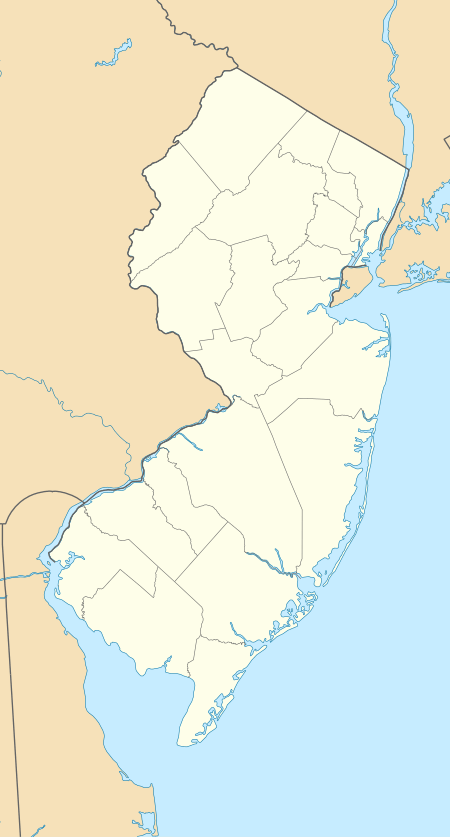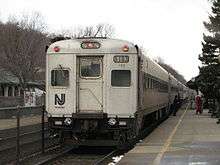Ridgewood station
Ridgewood is a railroad station operated by New Jersey Transit in the village of Ridgewood, Bergen County, New Jersey, United States. A major transfer station, Ridgewood has two high-level platforms (one side platform and one island platform) for the Main Line and Bergen County Line.
Ridgewood | ||||||||||||||||||
|---|---|---|---|---|---|---|---|---|---|---|---|---|---|---|---|---|---|---|
Ridgewood station in October 2014 from the Hoboken-bound platform. | ||||||||||||||||||
| Coordinates | 40.9807°N 74.1205°W | |||||||||||||||||
| Owned by | New Jersey Transit | |||||||||||||||||
| Platforms | 1 side platform, 1 island platform | |||||||||||||||||
| Tracks | 3 | |||||||||||||||||
| Connections | (all connections two blocks away at Van Neste Square; several of those routes have connections at the station on Godwin Avenue) | |||||||||||||||||
| Construction | ||||||||||||||||||
| Disabled access | Yes | |||||||||||||||||
| Other information | ||||||||||||||||||
| Station code | 2315 (Erie Railroad)[1] | |||||||||||||||||
| Fare zone | 9[2] | |||||||||||||||||
| History | ||||||||||||||||||
| Opened | October 19, 1848[3][4] | |||||||||||||||||
| Rebuilt | 1859[5] August 1915–November 28, 1916[6] February 2009[7]–September 2011[8] | |||||||||||||||||
| Previous names | Godwinville (1848–1866)[9] | |||||||||||||||||
| Traffic | ||||||||||||||||||
| Passengers (2012) | 1,433 (average weekday)[10] | |||||||||||||||||
| Services | ||||||||||||||||||
| ||||||||||||||||||
| ||||||||||||||||||
Ridgewood Station | ||||||||||||||||||
   | ||||||||||||||||||
| Location | Garber Square, Ridgewood, New Jersey | |||||||||||||||||
| Coordinates | 40°58′51″N 74°7′16″W | |||||||||||||||||
| Area | 5.5 acres (2.2 ha) | |||||||||||||||||
| Built | 1916 | |||||||||||||||||
| Architect | Drinker, W.W.; Howard, Frank A. | |||||||||||||||||
| Architectural style | Mission/Spanish Revival | |||||||||||||||||
| MPS | Operating Passenger Railroad Stations TR | |||||||||||||||||
| NRHP reference No. | 84002582[11] | |||||||||||||||||
| NJRHP No. | 647[12] | |||||||||||||||||
| Significant dates | ||||||||||||||||||
| Added to NRHP | June 22, 1984 | |||||||||||||||||
| Designated NJRHP | March 17, 1984 | |||||||||||||||||
History

Service to the area known as Godwinville began on October 19, 1848, with the opening of the Paterson and Ramapo Railroad, a railroad connecting the Paterson and Hudson River Railroad at Paterson to the New York, Lake Erie and Western Railroad at Suffern. A new station was built in 1856, then in 1859. However, in August 1915, the Erie Railroad, now in control, started construction on a new pair of ornate station depots at Ridgewood, both of which opened on November 28, 1916.
The Erie Railroad built Ridgewood station in 1916 as a grade-separated elevated station. It has been listed in the New Jersey Register of Historic Places and National Register of Historic Places since 1984 and is part of the Operating Passenger Railroad Stations Thematic Resource.[11][12][13]
Until the 1960s, the station served passengers heading to Binghamton and other cities, en route to Chicago or Buffalo. The Erie Limited and the Lake Cities served passengers heading toward Chicago. The station received eastbound passengers from the Atlantic Express.[14] In final years of long-distance service, after the Erie's merger with the Lackawanna Railroad, unnamed trains ran to Binghamton, where passengers could switch to the Phoebe Snow after a layover. The discontinuing of the Phoebe Snow (1966) and the Atlantic Express (1965) marked the end of long-distance passenger service through Ridgewood.[15][16]
Ridgewood station underwent a major renovation project between 2009 and 2011 to make the station compliant with the Americans with Disabilities Act of 1990. As part of the project, high-level platforms were installed and the side platform on Track 1 was demolished to allow for the installation of an island platform that would serve Tracks 1 and 3, and replace Track 3's side platform, which was fenced off. Ramps were installed on both platforms and elevators were installed to carry passengers from the platforms to the floor of the underpass on Franklin Avenue.[7]
Station layout
The station features three platforms, one side platform for service to Hoboken, and an island platform for service to points north. The two platforms are mostly high-level, while one low-level platform is no longer in use. Underpasses beneath the tracks and beneath a bridge on Franklin Avenue connect the two platforms.
| P Platform level |
Track 3 | ← Main Line and Bergen County Line toward Waldwick or Suffern (Ho-Ho-Kus) ← Port Jervis Line limited service toward Port Jervis (Ho-Ho-Kus) |
| Island platform, doors will open on the left or right | ||
| Track 1 | ← Main Line and Bergen County Line toward Waldwick or Suffern (Ho-Ho-Kus) ← Port Jervis Line limited service toward Port Jervis (Ho-Ho-Kus) | |
| Track 2 | Port Jervis Line limited service toward Hoboken (Glen Rock – Main Line or Glen Rock – Boro Hall) → Bergen County Line toward Hoboken (Glen Rock – Boro Hall) → Main Line toward Hoboken (Glen Rock – Main Line) → | |
| Side platform, doors will open on the right | ||
| G | Street level | Station building, ticket machines, parking |
See also
- List of New Jersey Transit stations
- National Register of Historic Places listings in Bergen County, New Jersey
Bibliography
- Van Valen, James M. (1900). History of Bergen County, New Jersey. New York, New York: New Jersey Publishing and Engraving Company. Retrieved August 18, 2017.CS1 maint: ref=harv (link)
- Citizens Semi-Centennial Association (1916). Ridgewood, Bergen County, New Jersey, Past and Present. Ridgewood, New Jersey: Citizens Semi-Centennial Association.CS1 maint: ref=harv (link)
References
- "List of Station Names and Numbers". Jersey City, New Jersey: Erie Railroad. May 1, 1916. Retrieved November 23, 2010.
- "Main and Bergen County Line Timetables" (PDF). Newark, New Jersey: New Jersey Transit Rail Operations. November 7, 2010. Retrieved November 27, 2010.
- "Common Council". The New York Herald. October 17, 1848. p. 1. Retrieved June 18, 2020 – via Newspapers.com.

- "Ramapo and Paterson and Paterson and Hudson River Railroads". The Evening Post. New York, New York. December 7, 1848. p. 4. Retrieved June 18, 2020 – via Newspapers.com.

- Citizens Semi-Centennial Association 1916, p. 113.
- Citizens Semi-Centennial Association 1916, p. 114.
- "NJ Transit Begins to Improve Ridgewood Station" (Press release). New Jersey Transit. February 24, 2009. Retrieved February 14, 2010.
- Moving the Needle: 2011 NJ Transit Annual Report (PDF) (Report). New Jersey Transit. p. 12. Retrieved February 17, 2019.
- Van Valen 1900, p. 242.
- "QUARTERLY RIDERSHIP TRENDS ANALYSIS" (PDF). New Jersey Transit. Archived from the original (PDF) on December 27, 2012. Retrieved January 4, 2013.
- "National Register Information System". National Register of Historic Places. National Park Service. March 13, 2009.
- "New Jersey and National Registers of Historic Places". New Jersey Department of Environmental Protection - Historic Preservation Office. Retrieved 7 January 2015.
- Ridgewood New Jersey Transit Railroad Station Survey
- Erie Railroad timetable, April 27, 1958, Tables, 1, 2, 3
- 'Official Guide of the Railways,' December 1964, Erie Lackawanna section, pp. 247-50.
- 'Official Guide of the Railways,' December 1966, Erie Lackawanna section, pp. 201-5.
External links
![]()